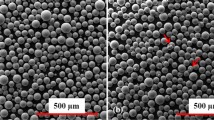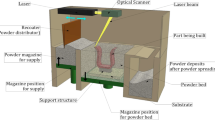Abstract
While electron beam melting is used to produce near net shape parts, it is still important to study geometrical defects since the final parts may include a serious change of geometry or considerable distortions and thus cannot match the desired geometry even after machining. For example, overhang geometries are very challenging to manufacture, because of the defects they present, such as warping, side loss, and raised edges. The objective of the present paper is to identify relations between the typical geometrical defects found in parts that include overhang volumes, especially side loss and warping defects. The originality of this study lies in the manufacture of a large number of Ti-6Al-4 V parts in order to carry out a statistical analysis of the results. Correlations are studied between the characteristic parameters of the defects and as a function of the manufacturing conditions. In addition, a principal component analysis is proposed to identify families of defects (modes). Finally, future prospects are discussed for designing parts with the aim of improving geometric quality and for simulating defects.





















Similar content being viewed by others
Data availability
All required data for this analysis are directly available into the paper. No additional data is needed.
Code availability
The code used to make the analysis of data is basic option of Matlab Software and authors use directly the measured rought data. No additional detail is required to verifiy the analysis and associated conclusion.
References
Taylor HC, Garibay EA, Wicker RB (2021) Toward a common laser powder bed fusion qualification test artifact. Addit Manuf 39:1–19
America Makes & ANSI Additive Manufacturing Standardization Collaborative (AMSC) (2018) Standardization roadmap for additive manufacturing V2
Rebaioli L, Fassi I (2017) A review on benchmark artifacts for evaluating the geometrical performance of additive manufacturing processes. Int J Adv Manuf Technol 93:2571–2598
Dimitrov D, Van Wijck W, Schreve K, De Beer N (2006) Investigating the achievable accuracy of three dimensional printing. Rapid Prototyp J 12(1):42–52
Cooke AL, Soons JA (2010) Variability in the geometric accuracy of additively manufactured test parts. In: Proceedings of 21st Annual International Solid Freeform Fabrication Symposium, Austin, TX, pp 1–12
Moylan S, Slotwinski J, Cooke A, Jurrens K, Donmez MA (2012) Proposal for a standardized test artifact for additive manufacturing machines and processes. In Proceedings of the 2012 annual international solid freeform fabrication symposium. Austin, TX, pp 6–8
Kruth JP (1991) Material increase manufacturing by rapid prototyping techniques. CIRP Ann Manuf Technol 40(2):603–614
Castillo L (2005) Study about the rapid manufacturing of complex parts of stainless steel and titanium. TNO Report with the Collaboration of AIMME
Piaget A, Museau M, Paris H (2017) Manufacturing space homogeneity in additive manufacturing - electron beam melting case. Stroj Vestn J Mech Eng 63(10):553–558. https://doi.org/10.5545/sv-jme.2017.4365
Lieneke T, Adam G, Leuders S, Knoop F, Josupeit S, Delfs P, Funke N, Zimmer D (2015) Systematical determination of tolerances for additive manufacturing by measuring linear dimensions. In 26th Annual International Solid Freeform Fabrication Symposium. Austin, Texas, USA, pp 371–384
Fahad M, Hopkinson N (2017) Evaluation and comparison of geometrical accuracy of parts produced by sintering-based additive manufacturing processes. Int J Adv Manuf Technol 88(9–12):3389–3394
Allaire G, Dapogny C, Estevez R, Faure A, Michailidis G (2017) Structural optimization under overhang constraints imposed by additive manufacturing technologies. J Comput Phys 351:295–328
Cheng B, Lu P, Chou K (2014) Thermomechanical investigation of overhang fabrications in electron beam additive manufacturing. Int Manuf Sci Eng Conf 45813:V002T02A024. Am Soc Mech Eng
Cheng B, Chou K (2015) \Geometric consideration of support structures in part overhang fabrications by electron beam additive manufacturing. Comput Aided Des 69:102–111
Béraud N (2016) Fabrication assistée par ordinateur pour le procédé EBM. PhD thesis, Université Grenoble Alpes
Tounsi R, Vignat F (2017) New concept of support structures in electron beam melting manufacturing to reduce geometric defects. In: 15e Colloque National AIP-Primeca, pp 1–6
Ghaoui S, Ledoux Y, Ballu A, Hoang T, Museau M, Vignat F, Villeneuve F (2019) Analyse de la variation géométrique des pièces produites en fabrication additive EBM-cas de pièces avec volume surplombant. In: 16e Colloque National S-mart
Piaget A (2019) Maîtrise de la qualité en fabrication additive. PhD thesis, Université Grenoble Alpes
Schmutzler C, Zimmermann A, Zaeh MF (2016) Compensating warpage of 3d printed parts using free-form deformation. Procedia CIRP 41:1017–1022
Schmutzler C, Bayerlein F, Janson S, Seidel C, Zaeh MF (2016) Pre-compensation of warpage for additive manufacturing. J Mech Eng Autom 6(8):392–399
Ghaoui S, Ledoux Y, Vignat F, Museau M, Vo TH, Villeneuve F, Ballu A (2020) Analysis of geometrical defects in overhang fabrications in electron beam melting based on thermomechanical simulations and experimental validations. Addit Manuf 36:101557
Dinwiddie RB, Dehoff RR, Lloyd PD, Lowe LE, Ulrich JB (2013) Thermographic in-situ process monitoring of the electron-beam melting technology used in additive manufacturing. Thermosense Therm Infrared Appl XXXV 8705:87050K. Int Soc Opt Photonics
Franchitti S, Borrelli R, Pirozzi C, Carrino L, Polini W, Sorrentino L, Gazzerro A (2018) Investigation on electron beam melting: Dimensional accuracy and process repeatability. Vacuum 157:340–348
Zäh MF, Lutzmann S (2010) Modelling and simulation of electron beam melting. Prod Eng Res Dev 4:15–23. https://doi.org/10.1007/s11740-009-0197-6
Juechter V, Scharowsky T, Singer RF, Körner C (2014) Processing window and evaporation phenomena for Ti–6Al–4V produced by selective electron beam melting. Acta Mater 76:252–258. https://doi.org/10.1016/j.actamat.2014.05.037
Al-Bermani SS (2011) An investigation into microstructure and microstructural control of additive layer manufactured Ti-6Al-4V by electron beam melting. PhD thesis, University of Sheffield
Hotelling A, Analysis H (1933) of a complex of statistical variables into principal components. J Educ Psychol 24(417–441):498–520. https://doi.org/10.1037/h0071325
Jolliffe TI (2002) Principal component analysis Springer New York. ISBN: 978-1-4419-2999-0
Lee S-D, Jang K-Y (2001) Identification of the deviation from the mean and multimodal distribution in the automotive assembly process: Correspondence analysis approach. Int J Prod Res 39(10):2105–2120. https://doi.org/10.1080/00207540110038522
Ballu A, Gomes R, Mimoso P, Cristovao C, Correia N (2017) Comparison of mode decomposition methods tested on simulated surfaces. Adv Mech Des Eng Manuf 1053–1062. Springer
Funding
This work was supported by the ANR GeoCAM, grant ANR-17-CE10- 0004 of the French National Research.
Agency (ANR).
Author information
Authors and Affiliations
Corresponding author
Ethics declarations
Ethics approval
The type of study is not concerned with ethical aspect.
Consent to participate
The authors fully agree to submit the manuscript the the journal JAMT.
Consent for publication
The authors fully agree to publish the manuscript the the journal JAMT.
Conflict of interest
The authors declare no competing interests.
Additional information
Publisher's note
Springer Nature remains neutral with regard to jurisdictional claims in published maps and institutional affiliations.
Rights and permissions
Springer Nature or its licensor holds exclusive rights to this article under a publishing agreement with the author(s) or other rightsholder(s); author self-archiving of the accepted manuscript version of this article is solely governed by the terms of such publishing agreement and applicable law.
About this article
Cite this article
Ledoux, Y., Ghaoui, S., Vo, T.H. et al. Geometrical defect analysis of overhang geometry produced by electron beam melting: experimental and statistical investigations. Int J Adv Manuf Technol 122, 2059–2075 (2022). https://doi.org/10.1007/s00170-022-10040-6
Received:
Accepted:
Published:
Issue Date:
DOI: https://doi.org/10.1007/s00170-022-10040-6




